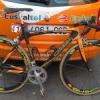I'm applying some to my right cheek to see I can tell any difference in skin tone over time. It's a long shot. No change yet.why on your face? any visible effects from that?Does anyone else here using DMSO regularly have the odor problem or the rash?
No odor problems though for the first week my face would burn slightly but that effect has gone away. I now add about 1/4 gram to my belly button smear some of the paste on my right knee and face. I take about another 2 grams to milk.
Hi Missminni,
Just Curious, I read this thread and wonder out loud:
Has anyone tried Resveratrol Mustard Plasters?
Maybe a way to transport RSV directly into the skin.
Looks like no one has tried MP yet.
Anyone out there know if this is feasible?
Happy New Year!
Bixbyte
I'm not sure what a mustard plaster is but I have used those camphor based chinese adhesive pads and had resveratrol/dmso on the skin that they covered. I had some sort of contact dermatitis on a spot on my back (I think brought on by a reaction to latex in a sport bra)
and I was experimenting. However I didn't do it consistently and I didn't notice any change. BTW, those adhesives (called External Analgesic) are great for sprains & bruises. They go by many different names i.e. Bao Zhen Gao and are very inexpensive. I was thinking perhaps they could be converted into a resveratrol patch.
As they come, they are made with Methyl Salicylate 13% and Menthol 7% and Camphor 7% and Chinese Wild Ginger and Chinese Sweet Gum Resin. I've used them for years. Maybe somebody who imports Chinese resveratrol could get them made with res and dmso instead. Maxwatt, is that a possibility?
ETA~Anecdotal stuff:
My friend started giving Resveratrol (98% pure powder) to her infirmed father. He has so much wrong with him and is on so many medications, I cannot even begin to relate them. He is in his 70's very overweight, and can barely walk a few feet. She started giving it to him about a week ago dissolved in milk, 1g 3x. He didn't mention feeling better or anything, but she kept it up. Yesterday, she rubbed his swollen ankles with res in dmso and almost immediately he felt such relief as he was able to get up and walk across the house, not something he normally can do, and called up to her to come down and do it some more. She had only rubbed it on his ankles and she said you could actually see an indent around his ankles where the swelling had gone down, whereas the feet and calves, where it had not been rubbed were still swollen.
Additionally, she rubbed it on a wrist injury her 70 yr old mother had for a period of time that had remained chronic, swollen and painful. Again, the res reduced the swelling to normal and relieved the discomfort and it's remained so, so far.
Edited by missminni, 26 December 2007 - 07:27 PM.
















































